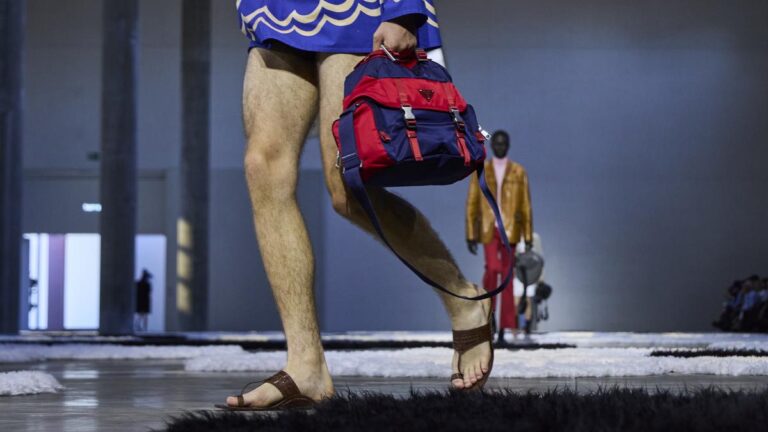When Italian luxury house Prada recently unveiled its version of the Kolhapuri chappal, Indian social media was quick to react. Accusations of cultural appropriation and erasure followed, accompanied by demands for proper attribution and a wider call to “decolonise fashion”. But what if the cultural erasure didn’t start with Prada, or with the West? What if the deeper, older story is not just about colonial appropriation, but about caste-based appropriation from within? Beneath the Indian diaspora’s outrage lies a deeper, more uncomfortable truth: the issue isn’t just about what is being borrowed, but who gets to borrow and who doesn’t. The Kolhapuri controversy exposes not only colonial legacies but also the casteist dynamics embedded within India’s cultural economy.
An artisan does stitching work inside her house in Kolhapur
| Photo Credit:
EMMANUAL YOGINI
Not just Indian, but Dalit in origin
Originating in Maharashtra’s Kolhapur region and its neighbouring districts, the Kolhapuri chappal is known for its durability and distinct structure. What is less commonly discussed is who makes them. Historical accounts of Kolhapuri craftsmanship often mention specific sub-castes such as the Chamar, Dhor, and Matang: scheduled caste communities historically assigned the task of leatherwork, a practice stigmatised due to its contact with animal hides.
These artisans, often from marginalised backgrounds, tan, dye, and stitch the leather by hand, creating a product celebrated for its durability and aesthetic. Yet, mainstream narratives often generalise Kolhapuris as a “Maharashtrian” or “Indian” craft, erasing the caste-specific labour behind them.
Artisans making kolhapuri chappals inside a Igna Leathers workshop in Kolhapur
| Photo Credit:
EMMANUAL YOGINI
Appropriation marketed as “revival”
Within India, cultural appropriation often wears the mask of reverence. Many Indian artforms, textiles, jewellery, and crafts originate from Dalit-Adivasi aesthetics, labour, and design but commercialised by upper caste (Savarna) owned businesses. When a luxury Indian label collaborates with artisans, it is seen as uplifting tradition. But these collaborations rarely involve co-authorship or equity. Artisans are paid per piece. Designs are owned by the brand. The origin story is softened into a marketing stunt. While artisans toil for minimal wages, the profits and prestige accrue to brands. Artisans, often from marginalised social backgrounds, form the backbone of India’s handicraft sector but lack control over branding or distribution. Savarna designers and brands act as gatekeepers, curating and profiting from these crafts while framing their role as “saviours of craft”.
An artisan polishes a kolhapuri chappal inside a store in Chappal market in Kolhapur
| Photo Credit:
EMMANUAL YOGINI
Who owns the means of design?
Indian fashion runways feature designers predominantly from Savarna castes. The narratives in Indian fashion are largely shaped by editorials run by upper-caste surnames. The leadership roles in the Indian fashion and textile sector are disproportionately represented by upper castes. Meanwhile, Bahujans remain largely invisible in decision-making roles, often limited to labour roles. Their labour, when filtered through a Savarna designer’s lens, becomes “art.” When done independently, it remains “ethnic” or “rural.”
Visitors shop Kolhapuri chappals inside a store in Chappal market in Kolhapur
| Photo Credit:
EMMANUAL YOGINI
Many traditional artisans lack access to formal design education, capital investment, or English-language fluency. Such barriers make it difficult for Bahujans to participate in the elite circuits of fashion. Bahujans are often reduced to tokenistic roles: a one season’s showstopper or a lookbook model, to signal performative inclusivity without ceding power. Bahujans are rarely seen in leadership roles, such as creative directors or brand owners, yet their identity is exploited in marketing campaigns that romanticise their poverty and struggles as “hardwork” or “heritage.” This tokenism commodifies Bahujan struggle while denying them agency, perpetuating a cycle where their labour is celebrated, but their voices are silenced.
The diaspora and the blind spot
The Indian diaspora’s calls to decolonise fashion often overlook these internal caste hierarchies. This blind spot is telling. National pride tends to eclipse caste critique. In calling out foreign appropriation, many forget to examine who within India controls narrative, capital, and authorship. The act is the same. The reaction shifts from outrage to celebration depending on who borrows and who gets to author the narrative.
Visitors shop Kolhapuri Chappals inside a store in Chappal market in Kolhapur
| Photo Credit:
EMMANUAL YOGINI
What cultural equity actually requires
The question isn’t whether Kolhapuris or any Indian craft should evolve. They must. But the more urgent question is: who gets to decide how they evolve? Who profits? Who gets cited in design schools and magazines, and who remains a footnote? True cultural equity is about fair wages, credit, representation in leadership roles and platforms for co-authorship in design and storytelling which rebalance historic exclusion.
The Prada-Kolhapuri controversy is more than a clash over sandals; it’s a mirror reflecting how global and local systems both flatten the histories of marginalised makers while uplifting those with socio-economic capital. Within the Indian fashion ecosystem, the intersections of caste and class dictate who gets to be the “designer” and who remains the uncredited, underpaid and exploited “artisan.” Until credit, compensation, and representation are equitably shared, cultural appropriation — whether by Prada or privileged Indian elites — will remain a form of theft, rooted in both colonial and casteist legacies.
The writer is a Chennai based fashion designer, artist and educator
Published – July 04, 2025 05:02 pm IST



